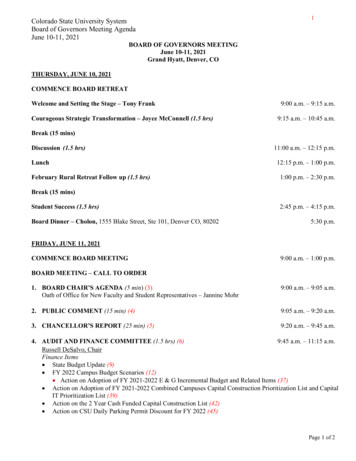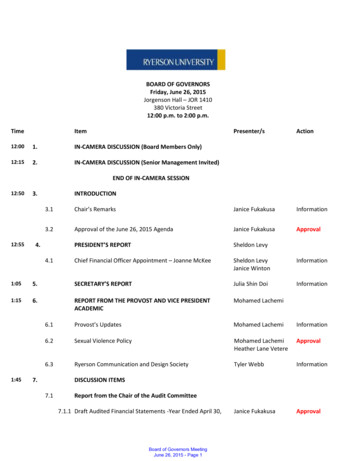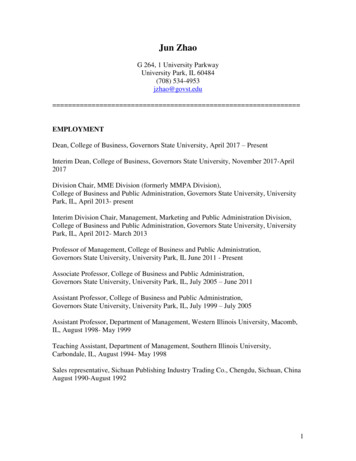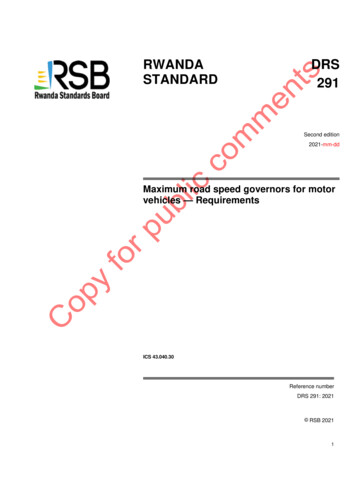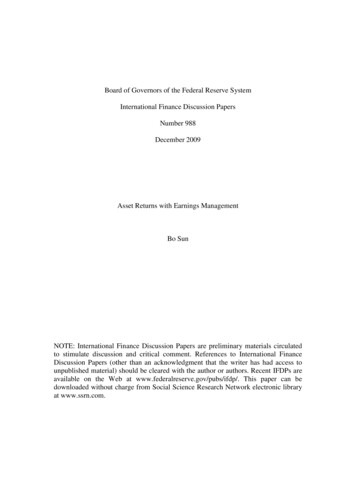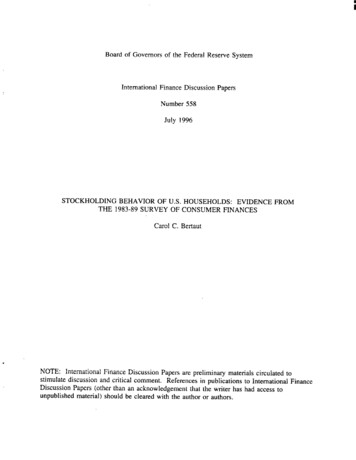
Transcription
Board of Governors of the Federal Reserve SystemInternational Finance Discussion PapersNumber 558July 1996STOCKHOLDING BEHAVIOR OF U.S. HOUSEHOLDS: EVIDENCE FROMTHE 1983-89 SURVEY OF CONSUMER FINANCESCarol C. Bertaut8NOTE: International Finance Discussion Papers are preliminary materials circulated tostimulate discussion and critical comment. References in publications to International FinanceDiscussion Papers (other than an acknowledgement that the writer has had access tounpublished material) should be cleared with the author or authors.
ABSTRACTMost households persistently invest in riskless assets but not stocks, and may do sobecause they perceive the information required for market participation to be costly relative toexpected benefits. In a CCAPM, increased risk aversion, income risk, and lower resourcesreduce the information expense sufficient todeter stockholding. Bivariate probit analysisusing the 1983-89 Survey of Consumer Finances shows that households with lower riskaversion, higher education, and greater wealth who were nonstockholders in 1983 had anincreased conditional probability of entering by 1989, while 1983 stockholders with lowerresources, more limited education, and greater risk aversion were more likely to benonstockholders by 1989.
STOCKHOLDING BEHAVIOR OF U.S. HOUSEHOLDS: EVIDENCE FROMTHE 1983-89 SURVEY OF CONSUMER FINANCESCarol C. Bertautl1. IntroductionFinancial advisors stress the importance of investing part of the household portfolio instocks to provide adequate resources for retirement, as well as to meet rising costs of acollege education, and to provide for the possibility of nursing home or other long-term carefor household members or elderly parents.Typical investment profiles for young, middleaged, and older households recommend at least some investment in stocks, with theproportion of the portfolio in stocks highest for young households who have the longestinvestment horizons. However, despite a historic excess return on stocks over short-termriskless assets of over 600 basis points’, most U.S. households do not invest in the stockmarket. Only 20 percent of U.S. households held publicly traded stocks or shares of mutualstock funds in 1983, according to the SurveyOfConsumer Finances.Despite the growth ofmutual stock funds, this percentage was about unchanged in 1989, and had only increased toabout 28 percent in 1992. Adding stocks held indirectly in IRAs, 401Ks, and defined benefitpensions increases the stock ownership to 38 percent of the population in 1992. While manynonstockholders have few financial assets at all, the puzzle of nonstockholders is by no meansrestricted to low-wealth households. In 1992, 45 percent of households with holdings of.‘ The author is an Economist in the Division of International Finance, Board of Governorsof the Federal Reserve System. I am grateful for many helpful comments and suggestions fromMichael Haliassos and Martha Starr-McCluer, and I also gratefully acknowledge comments andsuggestions on an earlier version of this paper from Martin Baily, Allan Drazen, William Evans,John Haltiwanger, and Andrew Lyon. Matthew Field provided excellent research assistance.This paper represents the views of the author and should not be interpreted as reflecting thoseof the Board of Governors of the Federal Reserve System or other members of its staff.
liquid riskless assets between 60,000 and 100,000 did not directly hold shares of stocks ormutual stock funds, and 28 percent of households with over 100,000 in liquid riskless ass@sdid not hold stocks directly?That most households hold incomplete portfolios has been recognized in empirical papers based on the original Surveys ofFinancial Characteristics ofConsumers conductedinthe early 1960s. Most of these papers motivatedincompleteportfoliosby assumingdifferential “monitoringcosts” for some assets, or by assuming that short sales restrictionsprevent individuals from optimally holding negative positions in some assets. The precisereasons for why households do not hold stocks are relevant for a wide range of papersestimating portfolio shares. Uhlerand Cragg (1971) investigated portfolio diversificationusing the 1960s Surveys, assuming that there exist “nuisance costs” to holding small quantitiesof some assets, which decrease with the amount held. King and Leape (1984) use the 1979Survey of Consumer FinanciaZDecisions while Perraudin and Sorensen (1991) use the 1983Survey of Consumer Finances to study the determinants of not holding certain assets in aparticular year, and then estimate asset demands. Age]] and Edin (1990) perform a similarexercise using data on Swedish households.3 King and Leape (1987) attribute the limitedincidence of stockholding to the exogenous and random arrival of information over time,implying that age should contribute to the probability of being a stockholder. Ioannides(1992) studies the effects of changes in variablesrelatingto the life cycle on portfolioshares.Haliassosand Bertaut (1995)exploretheoreticalreasonswhy individualhouseholdsabstainfrom stock market participation. Using data for the 1983 Survey of Consumer Finances, theyfind econometric support for the hypothesis that actual or perceived costly information aboutthe stock market can account for agents who hold portfolios of riskless assets but not stocks.This paper estimates a bivariate probit model using the most recent panel data fromthe 1983 and 1989 Surveys of Consumer Finances and focuses specifically on the decisionof.,2
whether to hold stocks. By looking at households six years apart, it can assess howhousehold characteristics and major life changes affect portfolio allocation. If costlyinformation about the stock market can deter households from participation, then householdportfolios are likely to display persistent behavior, and the probability of consistently being astockholder or a nonstockholder should exceed the probability of changing stockholder status.Conditional on being a nonstockholder in 1983, the probability of becoming a stockholder by1989 should be larger for households with greater ability to process financial information orto hire financial advisors. If costs of monitoring the portfolio recur each year, a lower levelof education or lower wealth should contribute to the decision to leave the stock market in1989, after having held stocks in 1983. The standard CCAPM and the role of information ormonitoring costs in deterring stock market participation are presented in Section 2. Section 3presents an econometric model for investigating stock market participation among U.S.households. Details of the data set are presented in Section4.Section 5 presents resultsfrom the bivariate probit estimation, and section 6 concludes.2. The Stockholding Puzzle and Information Costs ina BasicConsumptionCapital Asset Pricing ModelIn the basic Consumption CAPM, each agent maximizes expected utility. The utilityfunction is additively separable, and future utility is discounted at the rate . The agent canborrow or invest in two assets, one with a riskless rate of return and one with stochasticreturn (stocks). The agent’s optimization problem is:Max E 1 0subject to the constraints ’U(c,)(1)
ct A, y, - s,A r ] st(l r ) cx,z,where: Ctis real consumption in time t, y is exogenous real labor income in t, Atis totalwealth at time t, St is total real saving in t, is the amount saved in the risky asset in time t ,l r is the gross riskless return, and z, is the excess return on stocks over the riskless rate.The Bellman equation for the problem becomes:{U(c,) EIV, l(A, lIt]}V,(A,) ‘ax v ,(2)Imposing the constraints and solving for the optimal choices of total saving s and risky assetsa generates the first order conditions for time t:k:.-.:.“”U’(c, ) P(1 r) E,U ‘(c, ,)(3)(4)The stockholding puzzle arises from FOC (4), which cannot be satisfied by holding zero riskyassets in both periods t and t l whenz,,the expected equity premium, is positive.If we introduce a “cost” of stock market participation, representing either the lumpsum expense of obtaining information by purchasing investment guides or subscribing toinvestment magazines, or the opportunity cost of the time spent in obtaining investmentinformation,4 the constraints become:
c, Al y, - I -S,A I ] s, (1 r) a rr if the household makes the necessa expense I and invests in stocks, orCt A, Y, - s,A / 1 —– s, (1 r)if the household does not acquire the information and invests in riskless assets only.If the cost of acquiring the information necessary for market participation is perceived to besufficiently high to remove the expected utility gain, the household will not make theexpenditure. If costs are not just “ticket fees” that permit participation, but some fraction alsorecurs each period as the expense of monitoring of the portfolio and learning of newinvestment opportunities, they may be sufficient to make an individual persistently abstainfrom the market.Simulations of a calibrated life-cycle model allow investigation of how this “cost”varies by degree of risk aversion, with the introduction of labor income risk, and with theintroduction of a bequest motive. The income process used is described in detail in Bertautand Haliassos (1996).Households are assumedto live forthree 20-year periods, andtoreceive exogenous labor income in each period. Incomes are calibrated from the averageincome of households with the same age and level of education in the 1992 Survey ofConsumer Finances, distinguishing between those without a high school diploma orequivalency degree, those with a high school diploma but no college degree, and those with acollege degree or more. This classification is motivated by similarities of long-run incomeprocesses of such households (see Hubbard et. al., 1994, 1995). When income risk ist5
introduced, households face transitory and permanent income shocks which also vary byeducation level, following the process defined in Hubbard et. al. The riskless return is set tothe mean riskless rate estimated by Siegel (1992) over the period 1800-1990, which is similarto the Mehra-Prescott riskless return. Stock returns can take a high or low value with equalprobability, matching the first two moments of the Mehra-Prescott long-run empiricaldistribution. The expected value and standard deviation of 20-year holding returns arederived following the process described in Haliassos and Lyon (1994).Households are assumed to have CRRA utility functions with (constant) degree ofrelative risk aversion y. A bequest motive is introduced by allowing for a bequest G in thethird period:1-y-1U(C3,G) (1 -k) c’ k G ‘-y ‘11 -y1 -’ywhere the parameter k controls the choice between last-period consumption and bequest. Ifhouseholds care about bequests, they will behave so as to leave a bequest in any state of theworld. Under CRRA utility, the model cannot be solved analytically, and instead is solvednumerically. The level of information cost sufficient to deter stock market participation issolved for as the (endogenous) reduction in resources sufficient to yield the same expectedutilitythe household would receive by investment in riskless assets alone, under theassumption that the information cost is paid prior to investment in the first period, and onefourth of the cost recurs in the second period of life.Chart 1 shows the ratio of information cost relative to first period income that wouldmake the household indifferent between undergoing the information expense to invest instocks, and forgoing the expense and investing in riskless assets only, for households at eachof the three education levels, by degree of risk aversion. If the ratio of information cost toincome falls below the plotted line, the household will be better off by undertaking the.,6
information expense and investing in the stock market. For any ratio of cost to income abovethe line, the household will not wish to undertake the information expense, and will havehigher expected utility by investing only in riskless assets. The ratio of the information costsufficient to deter investment in stocks relative to first period income is highest for collegeeducated households. Although these households have thehighest first period income, theutility gains to stock market investment for these households are sufficiently large that itwould take a large information expense todeter their participation. At each level ofeducation, the income cost is a decreasing function of the degree of risk aversion. For anydegree of risk aversion, the introduction of (uncorrelated) income risk lowers the informationcost sufficient to deter investment. The addition of a bequest motive, however, increases theinformation cost. Households that care not only about their own future consumption but planto leave a bequest as well have a greater incentive to participate in the stock market and takeadvantage of the expected equity premium, and consequently the information cost required todeter their pa icipationi shigher.3. Specification of the model of stock market participationIn the standard Consumption Capital Asset Pricing Model (CCAPM), demands foreach asset are determined jointly, and the specification of asset demands should considersimultaneously the portfolio choice across all possible asset combinations. When we allowfor the possibility of incomplete portfolios where not all assets are held, the number ofpossible asset combinations is 2“-1, which becomes very large as the number of assets (n)rises. Studies which have tried to estimate the simultaneous decision have resorted to veryaggregated portfolio combinations to make the estimation feasible IUhler and Cragg (1971),King and Leape (1984), Perraudin and Sorensen (1991)]. However, if the aim is to estimatethe probability of ownership of a particular asset, then a reduced-form equation which does7
not includeother asset demandscan reestimated separately. This approachis also used byIoannides(1992) and Agell and Sorensen(1990).As in the standardCCAPM,householdsare assumedto maximizeutility of.consumption, and for estimation, we assume that the household’s indirect utility function canbe written as a linear function of household characteristics plus an error term ui. Letbe the indirect utility function when households invest in the stock market, and letu2i ‘*j ‘2[be the indirect utility function when households do not invest in the stock market.The Xi’sare observable variables pertaining to household i’s characteristics. These includecurrent wealth and income,and measuresof the parametersof the utility function,such asdegreeof risk aversion,rate of time preference,and the intentionof leavinga bequest. TheXI’Salso includevariablesthat may help explain apparentunderinvestmentin stocks ifinformationcosts are importantfor the stockholdingdecisio such as level of eductiion,access to financial market information, and age. The level of education may also beindicative of future income prospects, which in turn may influence portfolio decisions, asdemonstrated in Bertaut and Haiiassos (1996). The ui error terms include unobservedhousehold-specific factors that may be important for the stockholding decision. In practice,the indirect utility function is not observable, and we instead observe a dummy variable ofparticipation or nonparticipation in the stock market:.8
Di 1lfUzi C ‘ii ;that is, the household’s utility when holding stocks is higher than when not participating in thestock market, andDi Ootherwise.Then the probability thatDi 1 P( Uzi ‘Ii) P(X2,B2 MziC x,i ] ‘]i) P(u2i - U,i ‘lip j - ‘ i ) P(ci xi.3 ).With the assumption that the error terms Eiare normally distributed, this dichotomous choicemodel can be estimated by probit maximum likelihood.Since we have access to panel data with household portfolio choices in two years, wecan specify a bivariate model and allow for unobserved heterogeneity resulting fromhousehold-specific factors with correlation p between the disturbances for each household i:eit pi vi,; e,, - N((), 62)If the errors are jointly normally distributed, the equations for 1983 and 1989 can beestimated by bivariate probit. The variance of ei ,62, is normalized to 1 because only theratio of /(s can be identified by probit maximum likelihood.
The probabilities that enter the likelihood function are then given by the bivariate normalcumulative distribution function:.W’,: ho,,Prob (Y1 yil, Y2 yi2) @ (Wil,wi2, i*) JJQ(Zi] 9Zi 9pi*) ‘Zi,dziz-*whereWil (Zyi, -1 )p ,’xil}\?i, (Zyi, -1 )p2’xi2P*- 1)(2yi - l) l’x,] ’xi pf (Zyi,and-1 /2 (M.,: w.,; - 2p,*w,, w,,) /(1 - P,*)2 (wi],wi2, Pi*) e2Z(1 - pi )l’zis the bivariate normal density.4. Data from the 1983/1989 Panel Survey of Consumer FinancesThe data set used for estimation is the 1983 and 1989 panel of the Survey ofConsumer Finances. This panel data set contains detailed information on householdportfolios and incomes, and respondent attitudes towards financial risk, liquidity, use of credit,and masons for saving at two points in time. The sample used for this paper categorizes asnonstockholders in 1983 the 68 households who owned stocks only in the company in whicha household member was employed, and 75 such households as nonstockholders in 1989.Because costs associated with acquiring such stocks are minimal compamd with holding otherstocks, and returns to such stocks may have different covariance properties with householdlabor income, the behavior of these households may distort conclusions about variables,,10*
relevant for the decision to acquire stocks. Since we use several variables on respondentattitudes, the sample is restricted to households where the respondent is the same in bothyears. The resulting sample contains 1,368 households.Because observations are available for two periods in time, we can observe thestockholding decisions of households who hold stocks in both 1983 and 1989, those whoabstain from marketparticipationin both years, and those who changestockholderstatus.The percentage of the sample holding stocks in 1983 (34.7 percent) is about the same as in1989 (34.3 percent), but the composition of 1989 stockholders is not the same as in 1983.Nearly 25 percent of the 1983 stockholders in the sample did not hold stocks in 1989, aboutthe same percentage of 1989 stockholders who were nonstockholders in 1983 (see Table 1).5Specifying the model as a bivariate probit allows calculation not only of the probabilities ofthe four alternate stock market participation categories, but also conditional probabilities ofcontinued participation or nonparticipation.Table 1. Stockholder Composition in 1983 and or estimation of the 1983 and 1989 stockholding decisions, the set of respondentcharacteristics include dummy variables for sex, race, and marital status in 1983. Respondentage is included through a set of 10-year age-range dummies to investigate whether the abilityto overcome inertial reasons for nonparticipation--for example, through increased exposure toinformation--increases with age, or alternatively whether older households are deterred from11
stockholdingby the shorter investmenthorizonsthey may face. Dummyvariablesfocretirementin 1983,remainingretired in 1989,or becomingretired between 1983 and 1989tieincludedto capture these life-cyclechanges.Dummyvariablesare includedfor whetherthe householdhead had less than highschooleducationand if the head had a high schooldegree but no collegedegree, withobtaininga college degree as the omitted dummy variable. This ciistinction is important forthe extent to which higher education leads to greater financial sophistication and ability toacquire information necessary for market participation, but may also reflect long-run incomeprospects. More-educated households may have both a greater ability and incentive toovercome inetiial behavior by undertaking costs associated with stock market participation, asindicated in Chart 1. Chart 1 also shows that for any level of education, the addition of.income risk lowers the cost sufficient to deter stock market participation. To capture laborincome risk, dummy variables are included in the bivariate probit for having an occupationwith above or below average unemployment risk (see Data Appendix). A dummy variable isalso included for having a managerial occupation, since managers may have smallwopportunity costs to finding out about investment opportunities from being involved in relatedprofessional activities.Current household wealth is divided into financial and nonfinancial assets, to capturedifferences in portfolio decisions that may arise from liquidity considerations. Financial networth includes relatively liquid riskless assets, directly held stocks and shares in mutualfunds, bonds, trusts and other managed accounts, IRAs, and the cash value of life insurance,minus the total outstandingon consumerloans. Nonfinancialnet worth includesinvestment12
in real estate, automobiles and other consumer durables, net of any loans outstanding for theseassets. For both financial and nonfinancial net worth, the probit regression uses the log of thevalue. Current labor income is estimated as wage and salary income, income derived from aprofessional business or practice, unemployment or worker’s compensations payments, andincome from Social Security and other pensions, and is also included as the log of its value.Dummy variables are included for self-expressed risk aversion, measured by theindividual’s responses to questions in each year of how much financial risk he was willing totake for commensurate financial return. Households are coded as “willing to take aboveaverage or substantial risk to receive above average or substantial expected return,” “averagerisk to receive average return,” and the omitted dummy is “not willing to take any financialrisk.” As the calibrations in Chart 1 show, the utility gain from stock market participation issmaller for agents with greater risk aversion, so these agents can be deterred fromparticipation by relatively low costs of acquiring information. In a non-expected utilityframework that allows for “first-order risk aversion,” households can be deterred from stockmarket participation even if information is costless to them because their utility functions arenot differentiable at zero stock investment (Yaari (1987), Segal and Spivak (1990), andHaliassos and Bertaut (1995)). Dummy variables are also included for whether the householdconsidered itself to be credit constrained. Although Haliassos and Bertaut (1995) find that arestriction on borrowing against future income alone is not sufficient to deter marketparticipation,b relatively small information costs are required to eliminate utility gains fromparticipation by individuals for whom the constraint is binding. (Bertaut, 1993). FollowingCox and Jappelli (1993), a household was coded as being credit constrained if the respondent13
indicated that a request for credit had been denied, or less credit than requested had beengranted, and the household didnotsubsequentlyreceive thedesired amountof credit -elsewhere, or if the household did not apply for credit because it was expected that such arequest would be denied.For both years, a dummy variable is included for whether or not the respondent statedthat credit card balances were always paid in full. Paying offcredit card balances couldreflect either an absence of liquidity constraints or may be a measure of financial astuteness.’Dummy variablesare includedfor whetherthe majorityof wealth was inherited(in 1983)orwhethera sizable bequestwas received(in 1989),and whetherthe householdplannedto leavea bequest(in 1989). Stocks may be especiallydesirableassets for householdswith bequestmotives,becausecapital gains on bequeathedstocks escape taxation, As illustratedin Chart1, adding a bequest motive increasesthe informationcost necessa to deter stock marketinvestment. Additionally,if an inheritancereceivedwas partly in the form of stocks,thehouseholdneed not overcomeinitial inertialbehaviorto invest, and may continuetoparticipatein the market with little additionalexpendi m on information.Althoughthe holding perioddoes not matter for the standardCCAPM,a typical ruleof thumb is that stocks are considereda superiorinvestmentto bonds for householdswithinvestmenthorizons of five years or more. Dummy variables are included for whether therespondent indicated willingness to tie up funds to achieve above average financial return (in1983) and for having a main financial planning period of five or more years (in 1989).8Use of the panel data set allows for observation of life-style changes that may affectportfolio decisions. In addition to the variables on becoming or remaining retired, dummy14
variables are included for acquiring a new prima job or losing the 1983 prima job.Dummy variables are also included for changes in marital status: remaining married to thesame spouse as in 1983; becoming married between 1983 and 1989; and becoming divorced,widowed, or separated between the survey years. The omitted dummy is remaining single,Respondents who became married could increase stock ownership from marrying someonewho is already a stockholder, or from an increased interest in planning for the future. Wealso include variables measuring the (log of) the amount spent on financing educationbetween 1983 and 1989 and for whether the household bought a house during that period.These major expenses could be reasons for exiting the stock market.Details of all the explanatory variables are included in the Data Appendix. Table 2gives the characteristics of three composite respondents. A median or “typical” respondenthas all variables taken at their population median values.g This “typical” respondent has ahigh school education, is willing to take average financial risklO,has a low unemployment-riskoccupation, does not pay off credit card balances, did not inherit wealth, and does not intendto leave a bequest. The typical respondent is contrasted with composite individuals who havethe characteristics at the 25th percentile and the 75th percentile of the population. In contrastto the median household, the 25th percentile household is younger, is not willing to take anyfinancial risk, has an average unemployment-risk occupation, and lower financial andnonfinancial wealth and labor income. The composite household at the 75th percentile isolder, has college education, pays off credit card balances, plans to leave a bequest, and hashigher labor income and wealth.
5. Results from the 1983 and 1989 bivariate probit5.1. Coeflcient estimatesTable 3 presents the parameter estimates from the 1983-1989 bivariate probitregression. In both years, the parameterestimatesfor both financialand nonfinancialnet.worth are positive and significant. Non-financialwealth has a largercoefficientthan financialwealth in 1983 and a smaller coefficient 1989, suggesting no special role for the liquidity ofassets in predicting stock market participation. Household labor income is not significant ineither year. Results for variables capturing unemployment risk provide limited support for thenotion that labor income risk can influence market participation. Having an occupation withbelow average unemployment risk has a positive coefficient significant at the 9 percent levelin 1983, but an insignificant coefficient in 1989. The coefficient on having an occupationwith above average unemployment risk is not significant in either year. Having a managerialoccupation has an additional significant positive coefficient in 1983 but not 1989, suggestingperhaps that the information benefits of a managerial job were no longer present by 1989.All the dummy variables for education are highly significant, with higher levels ofeducation increasing the predicted probability of ever being a stockholder. The strength ofthese results even after controlling for wealth, current income, and unemployment risk,suggests that education captures a measure of the ability to process information about themarket and investment opportunities. However, because the level of education may also serveas a proxy for future expected resources, it is not possible to disentangle these two effects.The coefficients for both the dummy variable indicators of risk aversion (willingnessto take above average or significant risk for above average or significant financial return, and
willingness to take average risk for average return) are significantly different from the omitteddummy (not willing to take any financial risk) and from each other in both years. Cautionshould be used in interpreting these results, however, because there is considerable evidencethat self-expressed classifications of risk aversion are imperfect indicators of the respondent’sactual degree of risk aversion. Individuals may be describing their “ideal” portfolio, ratherthan portfolio choices they actually face.l 1 In addition, these respondent attitudes were notalways consistent over time. Many fewer sample households declared they were willing totake above average or substantial tisk in 1989, with nearly half of those giving this answer in1983 switching to average risk in 1989. Additionally, about 34 percent of those willing totake average risk in 1983 were not willing to take any risk in 1989. Although some of thesehouseholds that switched risk aversion category may have had adverse stock returnrealizations from the 1987 stock market drop, the majority of those switching from averagerisk to not willing to take risk were nonstockholders in both years, while the majority ofhouseholds that switched from above average risk to average risk were stockholders in bothyears.12The coefficients on the age-range dummies in
Survey of Consumer Finances to study the determinants of not holding certain assets in a particular year, and then estimate assetdemands. Age]] and Edin (1990) perform a similar exercise using data on Swedish households.3 King and Leape (1987) attribute the limited incidence of stockholding to the exogenous and random arrival of information .



